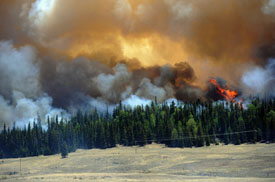Wildfire threatens nuclear facility in New Mexico
Firefighters battle a New Mexico wildfire, but officials say the Los Alamos nuclear weapons complex is under no immediate threat.

The laboratory has been shut down, and the adjacent town of Los Alamos, home to about 12,000 people, placed under a mandatory evacuation.
Flames reached the boundary of the 28,000-acre site, which is home to the nation’s largest supply of nuclear weapons, as fire crews attempted to douse spot fires carried onto the grounds by winds from the leading edge of the blaze.
Lab officials said on Monday night that radioactive and hazardous materials were safely beyond the fire’s reach, and that efforts in recent years to clear the area of dry brush and other potential ground fuels had paid off in helping firefighters keep the blaze at bay.
The facility has called in special teams to track readings from a network of 60 monitoring stations that measure levels of substances such as plutonium and uranium in the air “as a precaution”, according to lab director Charles McMillan.
“The health and safety of this community and our neighbours is our highest priority,” he said.
As of late Monday, the fire had scorched more than 50,000 acres in and around the Santa Fe National Forest, creeping to within four miles of the centre of the town of Los Alamos.
High winds had forced the grounding of water-dropping helicopters and airplane tankers, limiting fire defences largely to the use of bulldozers and hand tools.
A return of hot, dry, windy weather was expected to keep fire conditions extremely volatile.
Lab spokesman Kevin Roark said earlier that explosive materials on the laboratory’s grounds were stored safely in underground bunkers reinforced with concrete, steel and earthen berms. The complex was established during World War Two as part of the Manhattan Project to develop the first atomic bomb.
A Joplin resident sits where his home used to be, after tornado devastation (Reuters)
Extreme weather
The wildfires threatening Los Alamos are the latest in a series of extreme weather events in the US.
In early June flames tore across Arizona causing the state’s second largest wildfire. Hundreds of people were evacuated and thousands of firefighters were brought in to tackle the blaze.
In April and May hundreds of people were killed as deadly tornadoes spread across the American south.
President Obama was forced to declare a state of emergency in Alabama when the number of people killed there reached 131.
At the weekend the Souris river flooded the North Dakota city of Minot, affecting more than 3,000 homes and displacing more than 12,000 residents.
The rest of the world is also suffering from the effects of extreme weather.
A United Nations official has described the developing drought in eastern Africa as the worst in 60 years, with ten million people affected. The charity Save the Children says that conditions are becoming increasingly dire at the Dadaab refugee camp in Kenya, to which tens of thousands of refugees have fled.
Submerged homes in Minot, North Dakota (Reuters)

